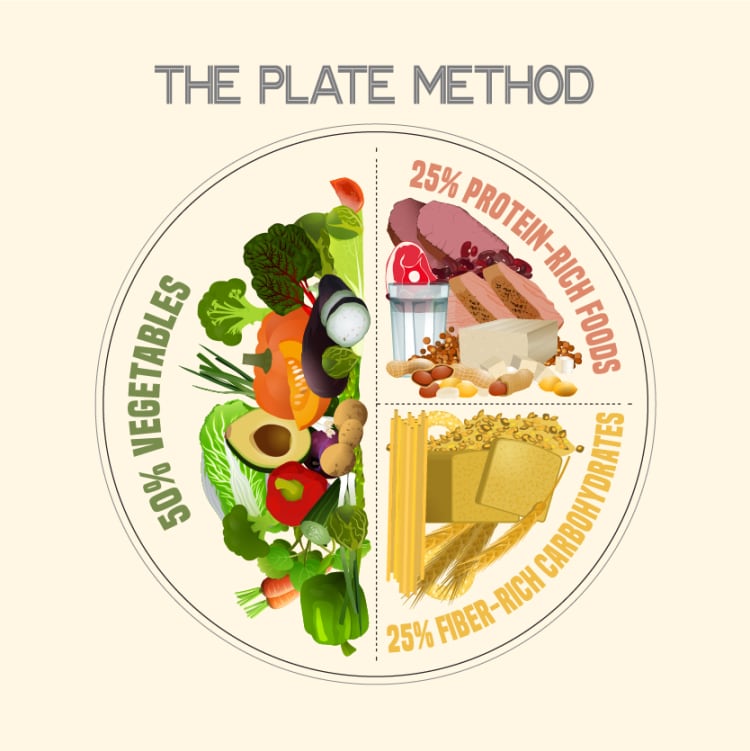'Carbohydrate budget'
Ideal meals for managing gestational diabetes.
Article Author: Katie McPherson
Article Date:

Each year, 2% to 10% of pregnant women are diagnosed with gestational diabetes, according to the Centers for Disease Control and Prevention (CDC). Those moms-to-be can easily get overwhelmed by the amount of information online about all the possible complications the condition can cause. However, most women with gestational diabetes go on to have healthy pregnancies.
Gestational diabetes happens when a woman’s body, now that it’s supporting two people, can’t make enough insulin for cells to use as energy. This occurs thanks to hormone changes that cause cells to use insulin less efficiently. An OB/GYN will test expectant mothers for this condition between 24 and 28 weeks of pregnancy, but may screen women at higher risk of developing it earlier.
Simplifying the gestational diabetes diet
One of the top recommendations from obstetricians to help manage gestational diabetes is changing your diet. Easier said than done, right? Catherine Wallace, MSH, is a clinical dietitian at the Outpatient Diabetes Center at Baptist Medical Center Beaches who works with patients with gestational diabetes often.
Wallace describes the gestational diabetes diet as a “carbohydrate budget,” taking your daily carb needs and divvying them up throughout the day, rather than carb-loading during a single sitting. She recommends three meals a day eaten four to six hours apart, each with 30 to 45 grams of carbohydrates. Visually, this is about as much rice as the size of your hand when you make a fist. She also recommends having snacks in between each meal, with 15 grams of carbohydrates per snack. Whenever possible, avoid added sugar and incorporate protein.
“Ideally, we want you eating more consistently throughout the day so your blood sugars are more stable,” said Wallace. “That means staying away from things with a lot of added sugar, like soda, and choosing whole grains and natural dietary fiber instead of processed carbohydrates. It also means eating smaller meals more frequently instead of three big ones with nothing in between.”
What’s in a carb?
Most people have no idea how many carbs are in a meal, so don’t worry if learning about carbohydrates takes some time. Wallace explains that a sub sandwich and chips contain between 75 and 90 grams of carbs, while a sandwich on whole-wheat bread with a side salad and berries is closer to 45 grams.
Also, carbohydrates aren’t the enemy. It’s just about learning how many carbs are OK for your body and pairing them with other helpful foods.
“There are three types of carbohydrates: sugars, starches and fibers. All three are important and we encourage pregnant women to eat carbs that contain natural sugars over added sugar since these foods, like whole fruit, also contain fiber, vitamins and minerals. However, sugar is fast-digesting, meaning it’s best to eat in smaller portions combined with protein and fiber to help balance blood sugar,” Wallace said.
Designing the ideal plate

Wallace also recommends patients with gestational diabetes follow the plate method, which visually divides a plate into half vegetables, one quarter protein, and one quarter carbohydrates. Keeping these portions in mind will help moms-to-be control their carbohydrate and sugar intake while still getting the carbs their body needs to, you know, grow a whole new person.
“The plate method is realistic and anyone can do it,” Wallace said. “I try to get the women I see to design their three meals around one protein source and a carbohydrate high in natural dietary fiber, meaning it contains 5 grams of fiber or more per serving. That combination stabilizes the blood sugar. Some examples of carbohydrates like that include beans, lentils, quinoa, sweet potatoes, whole wheat pasta or butternut squash.”
Staying positive
Wallace acknowledges some women have to measure their blood sugar multiple times a day, take insulin, and begin a new exercise regimen to manage gestational diabetes. It can feel all-consuming sometimes. The important thing is to remember why you're doing it all.
“The more information you gather, like your blood sugar numbers, the better control you have. It allows you to troubleshoot your meals. Did I eat too much? Does my body just not do well with that type of carbohydrate? You can’t figure that out if you’re not checking often enough. It helps you tailor your meal and snack choices based on what you respond well to.”
A day in the diet
So, what does a real day of eating this way look like? While planning meals and snacks does get easier over time, Wallace shares a few ideas to get you through your first grocery run.
- Breakfast: A cup of oatmeal with walnuts, or a whole-grain English muffin with eggs however you like them
- Snack 1: A low-sugar Greek yogurt, or fruit and nuts
- Lunch: A salad with protein and a piece of fruit, or half a sandwich and a side salad
- Snack 2: Cut vegetables and hummus, or air-popped popcorn
- Dinner: One protein, one carbohydrate, and one vegetable (other than potatoes) using the plate method
- Snack 3: Whole-grain crackers and cheese, or a glass of ultra-filtered chocolate milk (lower in sugar and higher in protein than traditional milk)
Are you looking for a provider who can help you manage gestational diabetes throughout your pregnancy? Call 904.202.4HER (4437) to find an OB/GYN. For more information about Baptist Health's Labor & Delivery services, visit baptistjax.com/baby.



